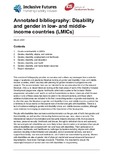Annotated Bibliography: Disability and Gender in Low- and Middle-income Countries (LMICs)
Abstract
This annotated bibliography provides an overview and outlines key messages from a selected range of academic and practioner literature looking at gender and disability in low- and middle-income countries, which may help with planning for gender inclusion in programmes and projects. The papers included here are not intended to be an exhaustive list of all the relevant literature. A focus is placed literature looking at the main areas of work of the Disability Inclusive Development programme: stigma, livelihoods (which also applies to the Inclusion Works programme), education, and health, as well as humanitarian contexts. Literature which focuses solely on one of these areas has been included in the relevant sections, and those which address multiple areas are included in the first, overarching section on gender and disability. As is often the case, the literature on gender and disability in low- and middle-income countries has a tendency to focus mainly on the experiences of women and girls with disabilities. There is a lack of evidence relating to gender and disability in low- and middle-income countries, although more evidence is emerging as awareness of the importance of the issue grows.
People with disabilities face exclusion and discrimination on the grounds of both their gender and their disability, as well as other intersecting factors such as age, race, class or poverty. The intersectional nature of discrimination and inequality impacts all areas of life, from access to services, personal security, livelihoods and leisure, through to individual choice and autonomy. Women and girls with disabilities are more likely to face discrimination and exclusion than people without disabilities and compared with men and boys with disabilities. Their participation in education, livelihoods, and healthcare is challenges by barriers including stigma and cultural practices resulting in discrimination and prejudice, lack of accessible services, and lack of support from family, teachers and institutions - all of which are exacerbated by poverty. Women with disabilities are also at greater risk of physical, mental and sexual abuse and because of stigmatisation, have lower marriage prospects. Therefore, it is important to ensure the meaningful inclusion of women and men with disabilities in programming.

